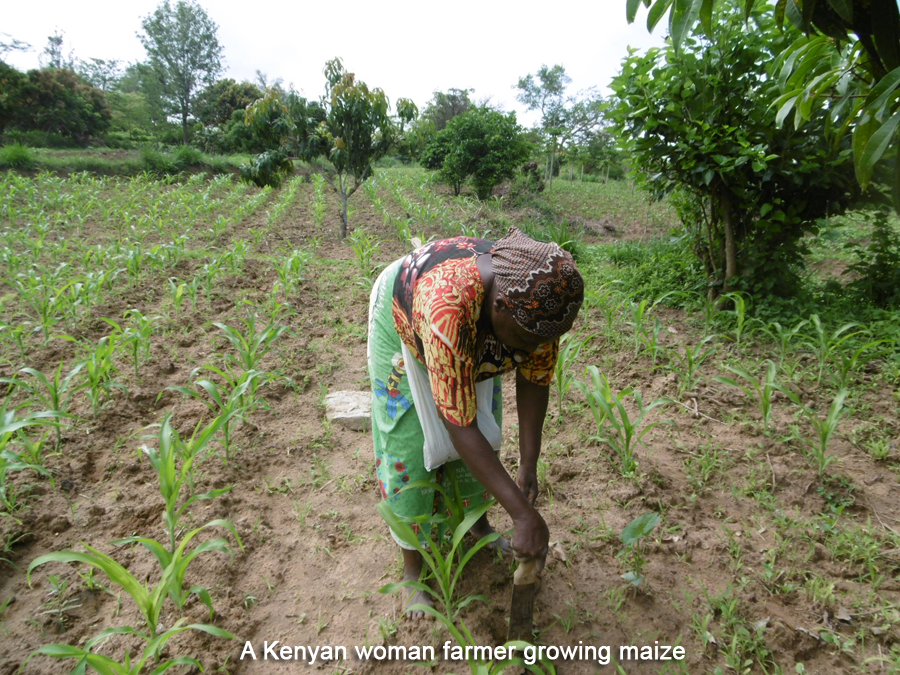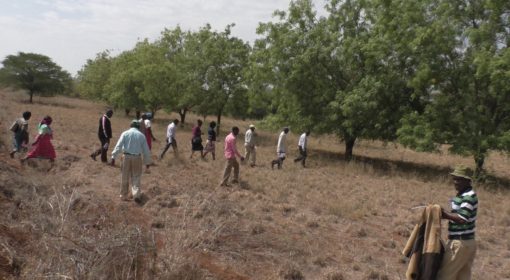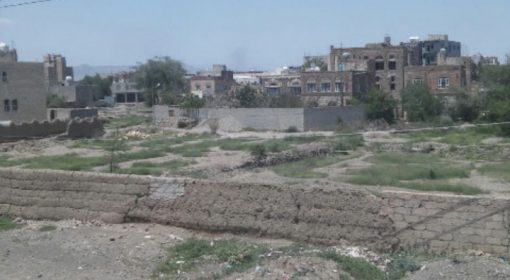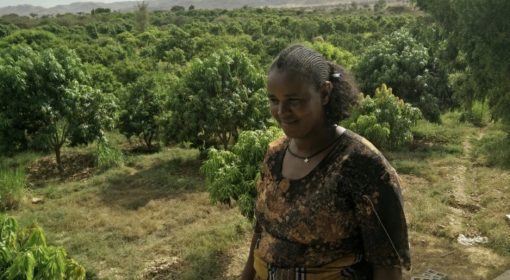The Maize Trap
“Maize is not food – food is maize”
Posted by Luwieke Bosma, Theophilus Kioko, and Michaeel Nzuki
April 14, 2017

Postcard from Ukambani, Kenya and greetings from madam Katuku Kioko, who has been farming maize, beans and coffee for nearly 40 years, and her son.
“I have been growing maize, ever since I started the farm since 1977. We used it mainly used for domestic consumption and had the surplus sold. Our farm is around 15 acres and , of which we use 10 ifor maize. When our children were with us, they would provide much of the labour on the farm and help in the post-harvest activities; such as taking the maize from the cobs, drying, storing and selling it. This went on until 2010, when all children moved away from the homestead. During this 40 years there were times with low rainfall, but compared to the years from 2010 onwards, the yields were much higher at that time. During the old days we would fill a whole storage room with maize, we would not even use bags. Nowadays we can get 5 bags of maize only”.
As her son explains: “From 2010 onwards much of our family labour was no longer available. So therefore now our parents decided to hire people to do the work. However, paying for daily labourers while obtaining low yields is a heavy burden. On top of that, labour prices are increasing in the area. The harvest they get is becoming too little to cater for the cost of farming. My mother knows that she is cultivating at a loss and complains about the cost of the labour that she has to hire”.
But even so, next year mother is planning to cultivate maize. She also bought fertilizers for 14000 KSH for the entire maize land. From the whole farm she would get 5 bags of maize, 100kg each, coming down to 10.000KSH sales. All the maize is for sale and nothing for own consumption: in fact, even though they grow maize, my parents buy their own maize flour from the shop.
Madame Katuku Kioko explains:: “Currently, our children have been suggesting to reduce the acreage of maize being farmed. But it is hard to do. How can I see myself during the on-set of rains not to be planting maize? If rains have come, I cannot imagine not to have maize in our farm. And what would people think of us: they have a fertile farm, but cannot seem to plant maize? “
Here is a story I always remember, Theophilus Kioko, son of Katuku Kioko explains: “During a drought in 2006, we used to keep some of our cows in a leased grazing land. Up to 2006, the cows would stay there all through. But now, after failing rains, the cows had to be taken back to the home. On the way there was a lady, who had not fenced her land, so all the maize was open to access from the road. The maize was already withered, in fact some of the leaves were blown by the wind. Expecting zero yield. Some of the cows would rush through the maize farm, being greedy with hunger. Then the lady was very bitter when she saw the cows in her farm. Then I asked her: Do you still think you will harvest anything from your maize farm? The response was: However the situation is, I still believe God can bring rain and I can be able to harvest this maize.”
In Ukambani food = maize. Even when people get food aid, it is basically maize. The preferred traditional Kamba food is Muthokoi, a mix of dehusked maize with beans. It is preferred over Githeri, in which the husk of maize remains. Preparing Muthokoi used to be done with the traditional mortar and pestle. This, however, resulted in a lot of waste: 4kg of the whole maize grain, would come down to 2kg of Muthokoi. In times of low maize harvests, people were not making Muthokoi.
Now with changing rain patterns becoming more unreliable and erratic, maize production is failing so frequently to many farmers for the last 5-10 years. Not only with Madam Katuko Kioko costs to produce maize outrun the sale of produce. However there are other crops that are more drought resistant and have a shorter time to mature. Take for example green grams, a crop hailed to have high returns in dry areas. However, many farmers in Ukambani have no appetite to grow green grams.
Mike Nzuki explains why: “When you do green grams, they are harvested in 1.5 months. But, the remaining soil moisture in your farms cannot support another cycle of green grams, so you will have to leave your land bare and at best use it for grazing. Other farmers will see you as non-serious, because you are not using the potential of your land for the right duration. Maize is the lifeline and the duration of growing maize, 3 months, is the norm and the standard. Everything below, is not considered to be appropriate. Also for maize there are improved varieties that are more drought resistant and fast maturing, but people prefer to plant indigenous varieties. Because of the duration of the crop that they are used to, it has become a habit.”
“Also when you plant green grams, and not maize, you cannot share the fresh, green maize with your neighbours. When maize is ready, everyone in the village is happy. In the homes everyone will roast the fresh maize and enjoy and eat. But if you only grow green grams, you have no chance to eat roasted maize; neither will neighbours share their maize with you. In fact, the whole village will look down upon you.”
Whatever the effects of recurrent droughts and the unattractive financial calculation – maize is a given. In Ukambani, to maize or not to maize is not a question.
{jcomments on}



